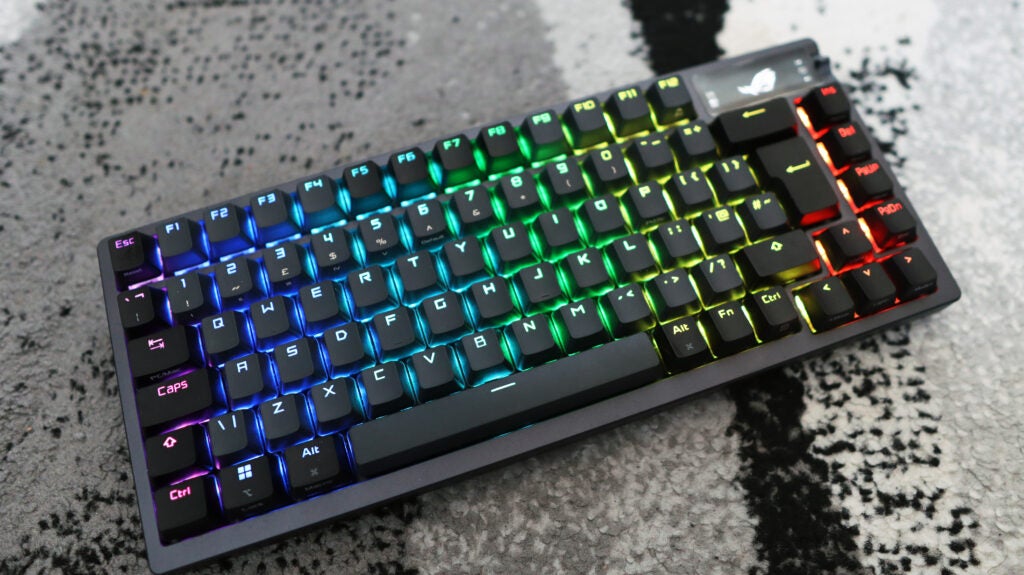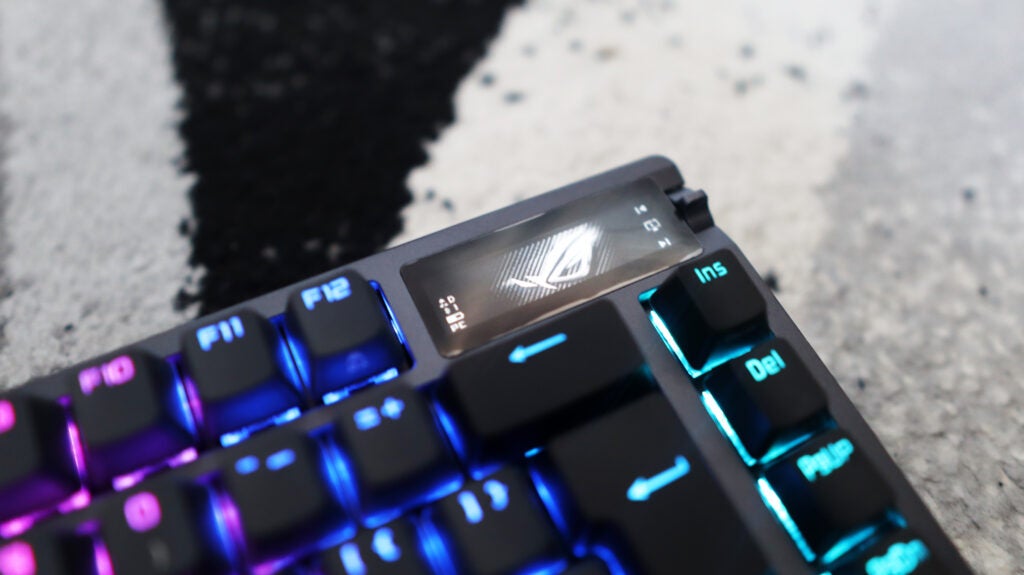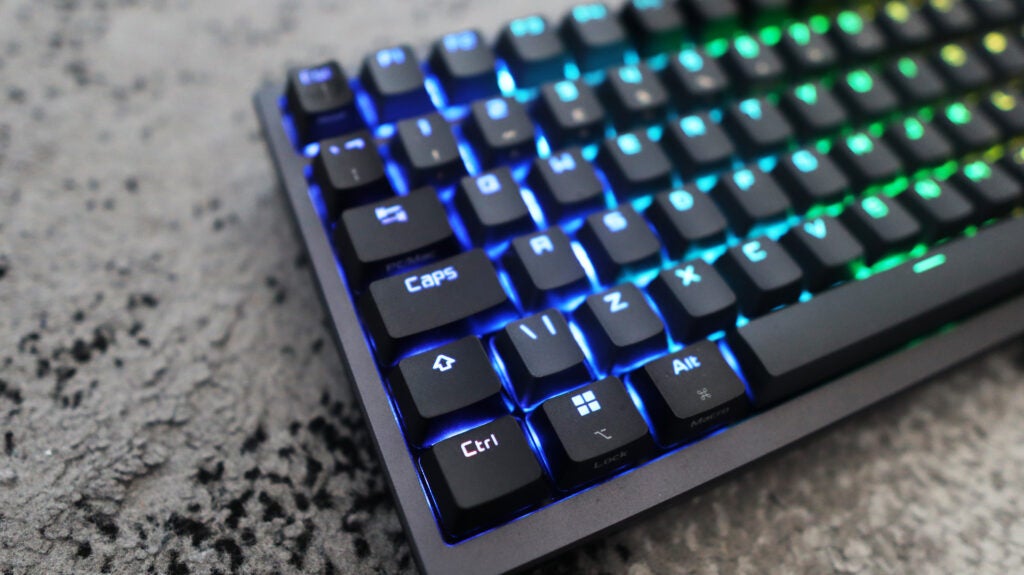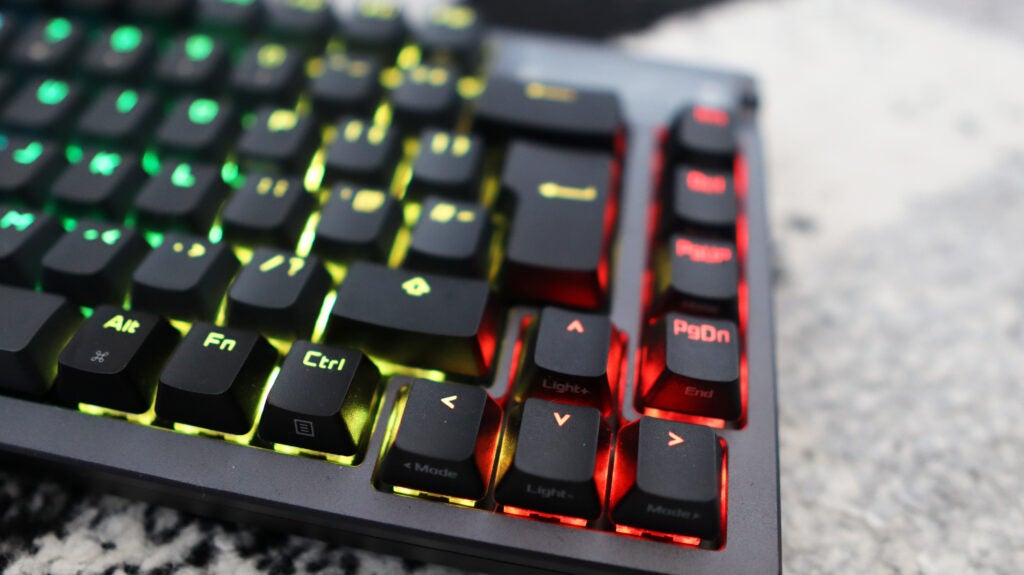Verdict
The Asus ROG Azoth is an incredible gaming keyboard with superb features such as hot-swappable switches and a bundled lubing kit. The keyboard is well built and offers one of the smoothest typing and gaming experiences I’ve ever had. The battery life and connectivity are solid too, but just watch out for the iffy software and especially high price.
Pros
- Incredible construction
- Gorgeously smooth typing feel
- OLED display is a fun addition
Cons
- Very expensive
- Software is a little bit fiddly
Availability
- UKRRP: £270
- USARRP: $290
- EuropeRRP: €299
-
Asus NX Red switches:Feature Asus’ own NX switches, with a 45g weighting, and they’re pre-lubed. -
OLED screen:It also features an OLED screen to display settings. -
Dual connectivity:Can connect via either Bluetooth or the bundled 2.4GHz USB receiver.
Introduction
The worlds of gaming keyboards and more enthusiast level choices have yet to converge, at least in the mainstream space. Finally though, it looks like our prayers have been answered with Asus’ brand new 75% gaming keyboard, the ROG Azoth.
A price of £270/€299/$290 means it is quite the expensive board, competing with some of the very best gaming keyboards out there. Here are my thoughts.
Design
- Solid construction
- OLED display is cool and functional
- 75% layout is an excellent choice
The Asus ROG Azoth borrows some cues from the likes of the Keychron Q1 with its 75% layout, giving you all the benefits of a TKL keyboard in a slightly squished up form in the name of more desk space. It’s become an increasingly common layout for enthusiasts, and on a personal level, probably sits as my favourite keyboard layout, alongside the weird HHKB layout.
As much as the layout and grey and black two-tone colouring of the Azoth may be borrowed a little from some other enthusiast-level keyboards, it’s otherwise quintessentially a ROG product.
There’s a certain aggressive nature to the looks of the Azoth, alongside the ribbed underside, which looks excellent. Build quality is sublime also, with both the metal top housing and plastic case ensuring no deck flex whatsoever, and a weighty frame that feels worth the high asking price.

The solid build quality is not only present on the Azoth’s frame, but also on all its fittings and fixings, including its textured PBT keycaps, which feel excellent under finger. These are composed of higher quality plastics than the more common ABS ones fitted to other keyboards, and are also resistant to the shine experienced on cheaper keycaps with extended use.
It may seem like a small thing to pick up on, but the keycaps are the part of a keyboard you’ll actually be touching and the fact these are textured PBT also seeks to justify the high price even more.
A key thing to note about the Azoth is its use of a multi-function OLED display, like that found on SteelSeries’ Apex Pro. With it, you can see key data such as the battery percentage, as well as media playback settings and controls for RGB lighting. There aren’t any multimedia controls on the keyboard in terms of a volume knob, but the small switch in the top-right corner can be configured in the absence of one and feels snappy, too.

In terms of its interface and connectivity, things are kept nice and easy, with everything you need to be housed on the top side of the Azoth. There you’ll find a USB-C port for wired connectivity and charging, as well as a switch to turn the keyboard on and choose between modes of connectivity, be it via Bluetooth or the 2.4GHz receiver.
The 2.4GHz receiver is housed inside the top side of the Azoth itself, which is especially neat. It means that you could use this as more of a portable keyboard if you wanted, although with its weighty frame, you will be lugging it around in a bag.
Performance
- NX switches feel especially smooth
- Hot-swappable PCB means you can swap others in
- Battery life is excellent, even with the OLED display on
Asus has bundled its own NX Red switches inside here, which feel light and buttery smooth, with a 45cN actuation force. As much as these may be MX Red clones, they feel as smooth and excellent as the originals. They do say imitation is the sincerest form of flattery, after all.
Not all clone switches feel as solid and as consistent as the NX Reds do, and a lot of that could be down to the fact they’re pre-lubed switches. In essence, this means the switches have been taken apart and their housings and components have been covered lightly with a lubricant to make them feel smoother and to remove any scratchiness from them.
It certainly makes a difference right out of the gate, although if you want to add any more, then Asus provides a small vial of switch lubricant in the box for you to try out, as well as an entire kit to allow you to lubricate the switches yourself, complete with holder. It’s a bit of a long and arduous process, but may well be worth it if you’re in search of the ultimate-feeling keyboard.

What also makes the Azoth an excellent buy for gamers and enthusiasts alike is that it’s a hot-swappable keyboard. This means you can chuck in any switches you like, whether they’re tactile, linear or clicky, and also conform to the MX standard of 3 or 5 pin mounting.
I don’t have many switches laying around, but I had a spare set of Cherry MX Speed Silvers to put in, and they felt excellent. Swapping the switches is especially easy as you simply grab a switch puller from inside the box, pull gently to get the switch out, and then replace it by making sure the pins line up with the socket, and then push down until it clicks into place.
The typing experience is a comfortable one, given the light, lubed switches. Intriguingly, this is also a gasket mounted keyboard, so the typing experience is, by design, a little bouncy, which makes things perhaps a tad more responsive and comfortable than more of a rigid keyboard with a metal plate running through it.
The NX Reds in here by default will also be more than up to the task of gaming. And while they may not be analog or have adjustable actuation points, they offer a light keypress which makes them an excellent all rounder. A few goes at CS:GO and Apex Legends when testing proved that to no end.

Wireless connectivity – with both options with Bluetooth and 2.4GHz – also make the Azoth an excellent keyboard to use on multiple devices at once. Switching between two devices, given there’s an actual physical switch on the topside of the keyboard, is especially easy. And the general reliability of both connections is solid, too. Bluetooth provides a bit more latency, but can work over longer distances and depletes battery at a slower rate.
On the front of battery life, Asus rates the Azoth to last for over 2000 hours (2076 hours to be exact) if you don’t have either the RGB or the OLED display on. This means you’ll be talking about weeks and months before needing to charge this board back up again. It’s testament to the great battery life that in my weeks of testing, I only had to charge it up once to full, and otherwise, it remained charged. With just the OLED display on and no RGB lighting, Asus also reckons you’ll get 130 hours, which still provides you with weeks’ worth of runtime before needing to charge it up.
Software and lighting
- Gorgeously vibrant RGB lighting
- ROG Armoury Crate is good, but incredibly slow
Unfortunately, it’s not an entire clean sweep for the Asus ROG Azoth. It’s let down on the software side with the fiddly ROG Armoury Crate that Asus has decided to employ here.
It’s sometimes insufferably slow to load up any functions, but what’s in here is pretty good. You can customise everything from the RGB lighting here to that OLED display to present custom animations or messages, as well as display system information, which is fun.
Despite this, the lighting on offer is excellent, and especially vibrant, as ROG products so often are. It provides a sea of colour with ease, and just looks great.
Latest deals
Should you buy it?
You want a gorgeous looking and feeling keyboard:
If it’s an especially sturdy and amazing looking gaming keyboard you’re after with great features, the Azoth is the one to go for.
You don’t want to drop nearly £300 on a keyboard:
Of course, a near £300 keyboard isn’t for everyone, and if you don’t want to spend that much, then there are other, more affordable choices that are amazing in their own right.
Final Thoughts
It’s great to see a keyboard from a mainstream manufacturer that blurs the lines between gaming keyboard aesthetic and enthusiast-level features and functionality. I’ve been crying out for the market to offer something like this for a while as a useful entry point into what can be quite a polarising and hard-to-understand hobby.
The Asus ROG Azoth is well built and comes with amazing functionality, be it the included lubing kit or the hot-swappable PCB for ultimate customisation. It may be expensive, but the ROG Azoth and all of its trimmings, makes for an incredible package.
How we test
We use every keyboard we test for at least a week. During that time, we’ll check it for ease of use and put it through its paces by playing a variety of different genres, including FPS, strategy and MOBAs.
We also check each keyboard’s software to see how easy it is to customise and set up.
Spent at least a week testing
Tested the performance on a variety of games
Compared the build quality with similar priced keyboards.
FAQs
Yes, this keyboard uses both 2.4Ghz and Bluetooth.
Yes, the Asus ROG Azoth allows you to swap in different switches.
Trusted Reviews test data
Sustainability
TrustedReviews’ holds the fact that global warming is not a myth as a core value and will continuously endeavour to help protect our planet from harm in its business practices.
As part of this mission, whenever we review a product we send the company a series of questions to help us gauge and make transparent the impact the device has on the environment.
We currently haven’t received answers to the questions on this product, but will update this page the moment we do. You can see a detailed breakdown of the questions we ask and why in our sustainability info page.
Jargon buster
Polling rate
The frequency of which a device sends signals to a computer. It’s especially important for gaming keyboards and mice, as it reduces the time it takes for an input to be registered, such as firing a gun at a target.
Verdict
The Asus ROG Azoth is an incredible gaming keyboard with superb features such as hot-swappable switches and a bundled lubing kit. The keyboard is well built and offers one of the smoothest typing and gaming experiences I’ve ever had. The battery life and connectivity are solid too, but just watch out for the iffy software and especially high price.
Pros
- Incredible construction
- Gorgeously smooth typing feel
- OLED display is a fun addition
Cons
- Very expensive
- Software is a little bit fiddly
Availability
- UKRRP: £270
- USARRP: $290
- EuropeRRP: €299
-
Asus NX Red switches:Feature Asus’ own NX switches, with a 45g weighting, and they’re pre-lubed. -
OLED screen:It also features an OLED screen to display settings. -
Dual connectivity:Can connect via either Bluetooth or the bundled 2.4GHz USB receiver.
Introduction
The worlds of gaming keyboards and more enthusiast level choices have yet to converge, at least in the mainstream space. Finally though, it looks like our prayers have been answered with Asus’ brand new 75% gaming keyboard, the ROG Azoth.
A price of £270/€299/$290 means it is quite the expensive board, competing with some of the very best gaming keyboards out there. Here are my thoughts.
Design
- Solid construction
- OLED display is cool and functional
- 75% layout is an excellent choice
The Asus ROG Azoth borrows some cues from the likes of the Keychron Q1 with its 75% layout, giving you all the benefits of a TKL keyboard in a slightly squished up form in the name of more desk space. It’s become an increasingly common layout for enthusiasts, and on a personal level, probably sits as my favourite keyboard layout, alongside the weird HHKB layout.
As much as the layout and grey and black two-tone colouring of the Azoth may be borrowed a little from some other enthusiast-level keyboards, it’s otherwise quintessentially a ROG product.
There’s a certain aggressive nature to the looks of the Azoth, alongside the ribbed underside, which looks excellent. Build quality is sublime also, with both the metal top housing and plastic case ensuring no deck flex whatsoever, and a weighty frame that feels worth the high asking price.

The solid build quality is not only present on the Azoth’s frame, but also on all its fittings and fixings, including its textured PBT keycaps, which feel excellent under finger. These are composed of higher quality plastics than the more common ABS ones fitted to other keyboards, and are also resistant to the shine experienced on cheaper keycaps with extended use.
It may seem like a small thing to pick up on, but the keycaps are the part of a keyboard you’ll actually be touching and the fact these are textured PBT also seeks to justify the high price even more.
A key thing to note about the Azoth is its use of a multi-function OLED display, like that found on SteelSeries’ Apex Pro. With it, you can see key data such as the battery percentage, as well as media playback settings and controls for RGB lighting. There aren’t any multimedia controls on the keyboard in terms of a volume knob, but the small switch in the top-right corner can be configured in the absence of one and feels snappy, too.

In terms of its interface and connectivity, things are kept nice and easy, with everything you need to be housed on the top side of the Azoth. There you’ll find a USB-C port for wired connectivity and charging, as well as a switch to turn the keyboard on and choose between modes of connectivity, be it via Bluetooth or the 2.4GHz receiver.
The 2.4GHz receiver is housed inside the top side of the Azoth itself, which is especially neat. It means that you could use this as more of a portable keyboard if you wanted, although with its weighty frame, you will be lugging it around in a bag.
Performance
- NX switches feel especially smooth
- Hot-swappable PCB means you can swap others in
- Battery life is excellent, even with the OLED display on
Asus has bundled its own NX Red switches inside here, which feel light and buttery smooth, with a 45cN actuation force. As much as these may be MX Red clones, they feel as smooth and excellent as the originals. They do say imitation is the sincerest form of flattery, after all.
Not all clone switches feel as solid and as consistent as the NX Reds do, and a lot of that could be down to the fact they’re pre-lubed switches. In essence, this means the switches have been taken apart and their housings and components have been covered lightly with a lubricant to make them feel smoother and to remove any scratchiness from them.
It certainly makes a difference right out of the gate, although if you want to add any more, then Asus provides a small vial of switch lubricant in the box for you to try out, as well as an entire kit to allow you to lubricate the switches yourself, complete with holder. It’s a bit of a long and arduous process, but may well be worth it if you’re in search of the ultimate-feeling keyboard.

What also makes the Azoth an excellent buy for gamers and enthusiasts alike is that it’s a hot-swappable keyboard. This means you can chuck in any switches you like, whether they’re tactile, linear or clicky, and also conform to the MX standard of 3 or 5 pin mounting.
I don’t have many switches laying around, but I had a spare set of Cherry MX Speed Silvers to put in, and they felt excellent. Swapping the switches is especially easy as you simply grab a switch puller from inside the box, pull gently to get the switch out, and then replace it by making sure the pins line up with the socket, and then push down until it clicks into place.
The typing experience is a comfortable one, given the light, lubed switches. Intriguingly, this is also a gasket mounted keyboard, so the typing experience is, by design, a little bouncy, which makes things perhaps a tad more responsive and comfortable than more of a rigid keyboard with a metal plate running through it.
The NX Reds in here by default will also be more than up to the task of gaming. And while they may not be analog or have adjustable actuation points, they offer a light keypress which makes them an excellent all rounder. A few goes at CS:GO and Apex Legends when testing proved that to no end.

Wireless connectivity – with both options with Bluetooth and 2.4GHz – also make the Azoth an excellent keyboard to use on multiple devices at once. Switching between two devices, given there’s an actual physical switch on the topside of the keyboard, is especially easy. And the general reliability of both connections is solid, too. Bluetooth provides a bit more latency, but can work over longer distances and depletes battery at a slower rate.
On the front of battery life, Asus rates the Azoth to last for over 2000 hours (2076 hours to be exact) if you don’t have either the RGB or the OLED display on. This means you’ll be talking about weeks and months before needing to charge this board back up again. It’s testament to the great battery life that in my weeks of testing, I only had to charge it up once to full, and otherwise, it remained charged. With just the OLED display on and no RGB lighting, Asus also reckons you’ll get 130 hours, which still provides you with weeks’ worth of runtime before needing to charge it up.
Software and lighting
- Gorgeously vibrant RGB lighting
- ROG Armoury Crate is good, but incredibly slow
Unfortunately, it’s not an entire clean sweep for the Asus ROG Azoth. It’s let down on the software side with the fiddly ROG Armoury Crate that Asus has decided to employ here.
It’s sometimes insufferably slow to load up any functions, but what’s in here is pretty good. You can customise everything from the RGB lighting here to that OLED display to present custom animations or messages, as well as display system information, which is fun.
Despite this, the lighting on offer is excellent, and especially vibrant, as ROG products so often are. It provides a sea of colour with ease, and just looks great.
Latest deals
Should you buy it?
You want a gorgeous looking and feeling keyboard:
If it’s an especially sturdy and amazing looking gaming keyboard you’re after with great features, the Azoth is the one to go for.
You don’t want to drop nearly £300 on a keyboard:
Of course, a near £300 keyboard isn’t for everyone, and if you don’t want to spend that much, then there are other, more affordable choices that are amazing in their own right.
Final Thoughts
It’s great to see a keyboard from a mainstream manufacturer that blurs the lines between gaming keyboard aesthetic and enthusiast-level features and functionality. I’ve been crying out for the market to offer something like this for a while as a useful entry point into what can be quite a polarising and hard-to-understand hobby.
The Asus ROG Azoth is well built and comes with amazing functionality, be it the included lubing kit or the hot-swappable PCB for ultimate customisation. It may be expensive, but the ROG Azoth and all of its trimmings, makes for an incredible package.
How we test
We use every keyboard we test for at least a week. During that time, we’ll check it for ease of use and put it through its paces by playing a variety of different genres, including FPS, strategy and MOBAs.
We also check each keyboard’s software to see how easy it is to customise and set up.
Spent at least a week testing
Tested the performance on a variety of games
Compared the build quality with similar priced keyboards.
FAQs
Yes, this keyboard uses both 2.4Ghz and Bluetooth.
Yes, the Asus ROG Azoth allows you to swap in different switches.
Trusted Reviews test data
Sustainability
TrustedReviews’ holds the fact that global warming is not a myth as a core value and will continuously endeavour to help protect our planet from harm in its business practices.
As part of this mission, whenever we review a product we send the company a series of questions to help us gauge and make transparent the impact the device has on the environment.
We currently haven’t received answers to the questions on this product, but will update this page the moment we do. You can see a detailed breakdown of the questions we ask and why in our sustainability info page.
Jargon buster
Polling rate
The frequency of which a device sends signals to a computer. It’s especially important for gaming keyboards and mice, as it reduces the time it takes for an input to be registered, such as firing a gun at a target.
























